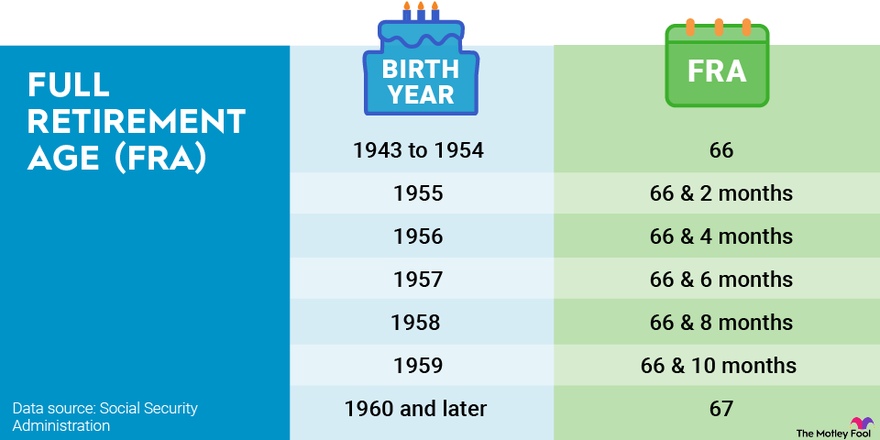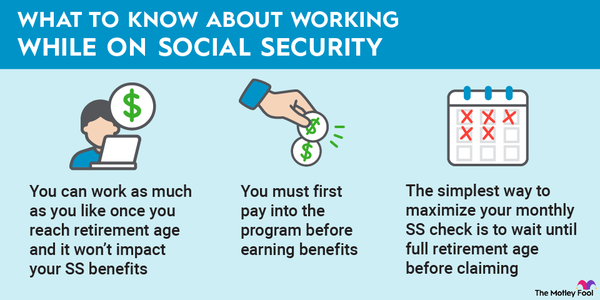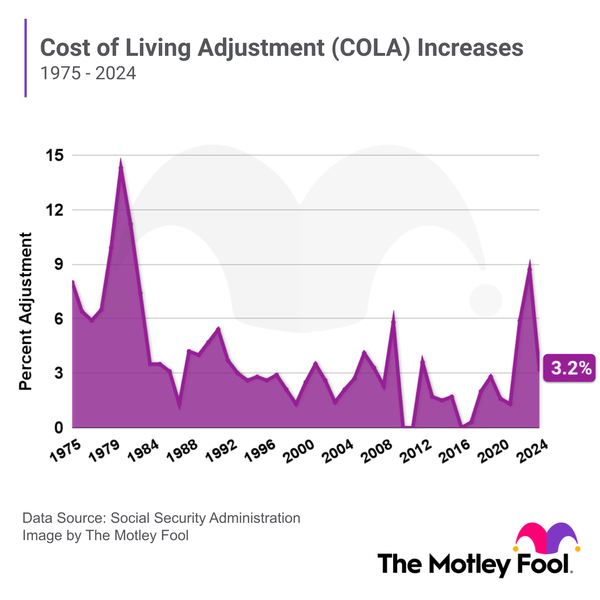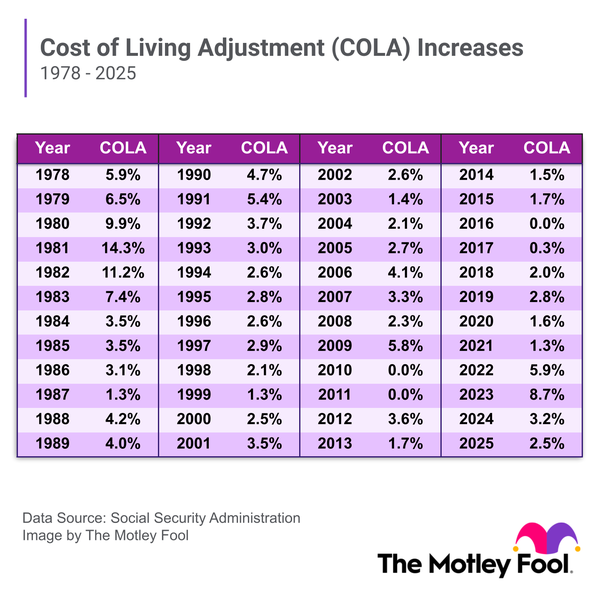You probably expect to get some money from the government in retirement, but how much you get depends on the Social Security benefits formula. Many don't understand how this formula works or when it applies, but it's not too difficult to figure out as long as you're comfortable with some basic arithmetic. Below, we'll break it down step by step so you can better estimate how much money you'll get from the program.
What is it?
What is the Social Security benefits formula?
The Social Security benefits formula is what the government uses to determine your primary insurance amount (PIA). That's the benefit you're entitled to if you sign up at your full retirement age (FRA). This is 67 for anyone born in 1960 or later.

Before the government can use the benefits formula, it must calculate your average indexed monthly earnings (AIME). This is your average monthly earnings over your 35 highest-earning years, adjusted for inflation. We'll talk more about calculating that below.
Once the government knows your AIME, it plugs it into the Social Security benefits formula in effect during the year you turned 62. The result is your PIA. But that's not always the same as your monthly benefit.
Some people choose to apply for Social Security before or after their FRA. If you claim early, you can start receiving benefits as soon as you turn 62. You'll get more checks this way, but each one will be smaller. You can also delay benefits and your checks will grow a little each month until you reach your maximum benefit at age 70.
In both of these cases, the government runs an additional calculation to determine how to adjust your PIA to determine your final monthly benefit.
Formula
Social Security benefits formula 2023
The Social Security formula for the year 2024 -- which applies to anyone born in 1962 -- is as follows:
- Multiply the first $1,174 of your AIME by 90%.
- Multiply any amount between $1,174 and $7,078 by 32%.
- Multiply any amount over $7,078 by 15%.
- Add the results from the three steps above and round to the next lowest $0.10.
So for example, if your AIME was $3,000, you would do the following:
- Multiply the first $1,174 by 90%, giving you $1,056.60.
- Multiply the remaining $1,826 by 32%, giving you $584.32.
- Multiply any amount over $7,078 (in this case $0) by 15%, giving you $0.00.
- Add the results from the three steps above, which gives you $1,640.92.
In the formula above, $1,174 and $7,078 are known as the bend points. These are the only parts of the Social Security benefits formula that change from one year to the next. In 2025, they will rise to $1,226 and $7,391, respectively. You can find the bend points for any previous year on the Social Security Administration website.
Calculating your benefits
How to calculate your Social Security benefits
If you simply want to know how large your Social Security checks will be if you sign up at a certain age, you can figure this out by creating a my Social Security account. But if you want to understand how the government arrived at this number, you can duplicate its work by taking the following steps:
1. Determine your wages for each year you've worked
The federal government keeps track of how much money you've paid Social Security taxes on each year in your earnings record. You can view this in your my Social Security account.
For most people, their actual income and the income they've paid Social Security taxes on are the same. But this isn't always the case with high earners. In 2024, for example, you only pay Social Security taxes on the first $168,600 you earn. If you earn $200,000 this year and your earnings record only shows $168,600 for 2024, that's correct. Your earnings record only reflects the income you paid Social Security payroll taxes on.
The ceiling on income subject to these taxes rises each year. In 2025, it will climb to $176,100.
2. Adjust your wages for each year for inflation
The government uses the Average Wage Index (AWI) to adjust your wages for inflation so it can accurately pick out the years you've earned the most. You can view the AWI for all previous years going back to 1951 on the Social Security Administration's website.
The AWI you use to adjust your wages is the one that was in effect in the year you turned 60. You divide this AWI by the AWI for the year you're adjusting wages for. The result is your index factor. Multiply this by your income as reported in your earnings record for that year to get your index-adjusted wages.
For example, if you turned 60 in 2022 (meaning you become eligible for benefits in 2024, when you turn 62), you'd use the 2022 AWI of $63,795.13 as your benchmark. If you earned $50,000 in 2015 and you want to calculate your index-adjusted income for that year, you'd do the following:
- Divide the 2022 AWI of $63,795.13 by the 2015 AWI of $48,098.63, giving you an index factor of about 1.326.
- Then you'd multiply your $50,000 in income from 2015 by 1.326 to give you an index-adjusted income of $66,300 for that year.
If that's a little too much math for you, you can skip the first step and go straight to the indexing factors. The Social Security Administration keeps lists of all the indexing factors for all years. You just have to enter the year you turn 60 and it will give you the index factors to use. Then all you have to do is multiply those indexing factors by your income for the appropriate year.
3. Calculate your AIME
After you've adjusted your income for inflation, total up the income from your 35 highest-earning years. If you didn't earn income in at least 35 years, then total your income for all the years you've worked.
Next, divide this total by 420 -- the number of months in 35 years -- which will give you your AIME. It may not be as high as you expect if you worked fewer than 35 years because you'll have some zero-income years factored into your calculation.
4. Apply the Social Security benefits formula
Once you know your AIME, you can plug it into the Social Security retirement benefits formula as outlined above. But remember to choose the correct formula for your age. You should use the one that was in effect in the year you turned 62 regardless of whether you signed up for benefits at that age.
The results you get from this step will give you your PIA. If you choose to sign up at your FRA, that's also how much you'll get for a benefit. But if you sign up before or after your FRA, there are a few extra steps to calculating your monthly benefit.
5. Adjust your PIA up or down as necessary
To do this step, you need to know what your FRA is. Here's a table to help you figure that out:

If you claim Social Security early, the government reduces your checks by:
- 5/9 of 1% per month up to 36 months
- 5/12 of 1% for each additional month if you claim more than 36 months early
For example, if your FRA is 66 and you claimed at 62, you'd lose 5/9 of 1% from your checks for each of the first 36 months you claimed early. So you'd multiply (((5/9) x 0.01) x 36) x 100 and you'd get a 20% reduction. But that's not all.
Then, you have to add a further 5/12 of 1% monthly deduction for claiming checks between 62 and 63. So you'd take (((5/12) x 0.01) x 12) x 100 and you'd get an additional 5% decrease. Added together, the two steps above result in 25% smaller checks for claiming at 62 as opposed to waiting until 66.
For those who choose to delay benefits past their FRA, the process is pretty similar. You add 2/3 of 1% per month for every month you delay past your FRA. However, this only continues until you turn 70. After that, your benefit won't grow any more.
6. Subtract your Medicare Part B premiums if necessary
The five steps above will tell you the kind of benefit you're entitled to based on your work history and claiming age, but that's not always the same as your take-home benefit. Seniors on Medicare have their Part B premiums automatically deducted from their Social Security checks.
In 2024, that's $174.70 per month, but it's increasing to $185.00 per month in 2025. If you're not on Medicare yet, you won't have to worry about this until you sign up for it.
7. Round your benefit amount down to the nearest dollar
The final step in calculating your take-home Social Security benefit is to round your answer from Step 6 down to the nearest dollar. Even if your result from the previous step was $1,680.99, you'd still round down to $1,680 rather than rounding up to $1,681.
A quick word on cost-of-living adjustments (COLAs)
Every year the government administers a cost-of-living adjustment (COLA) to help seniors' Social Security checks keep up with inflation. But it doesn't add the COLA to your take-home check. It adds it to your PIA.
If you want to calculate the size of your checks for next year, look at your PIA for the current year and add the COLA. For example, the 2025 COLA is 2.5%, so you'd take your 2024 PIA and multiply it by 1.025 to get your 2025 PIA. Then you proceed with Steps 5 to 7 above to determine your new take-home benefit for the next year.
Importance
Why is the Social Security benefits formula important?
Once you understand how the government calculates your Social Security benefit, you can use this information to boost your own benefit. For example, if you didn't know that the government based your benefit on your 35 highest-earning years, you might have retired before you worked that long. That would have resulted in zero-income years being included in your benefit calculation.
Understanding how your FRA plays into your benefit calculation can also help you choose the best time to sign up. This depends on your life expectancy and financial circumstances.
You can use the steps above to calculate your benefit at various claiming ages. Then multiply each of these monthly benefits by 12 to get your estimated annual benefit. You then multiply this figure by the number of years you expect to claim to get your estimated lifetime benefit. For example, if you expect a $2,000 monthly check at your FRA of 67 and believe you'll live to 87, you'd have an estimated lifetime benefit of $480,000.
Related retirement topics
The bottom line
The Social Security benefits formula might seem complicated, but it's not too difficult once you break it down. You may not be able to precisely calculate your benefit if you're too young for Social Security, but keeping these guidelines in mind can help you squeeze the most money possible out of the program.
The Motley Fool has a disclosure policy.



















